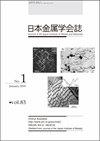Development of a Process for Recycling Platinum Group Metals Using Molten Alkali Metal Chlorides
IF 0.4
4区 材料科学
Q4 METALLURGY & METALLURGICAL ENGINEERING
引用次数: 3
Abstract
The platinum group metals (PGM: platinum, palladium, rhodium, ruthenium, iridium, and osmium) are widely used in electrical devices and in catalysts. It is important that sustainable methods of recycling PGMs in waste electrical devices and catalysts are developed because PGMs are expensive and new sources in the Earth's crust are limited. In this work, processes for recycling ruthenium, platinum, palladium, and rhodium based on chlorination in molten chloride flux are investigated. Scrap containing ruthenium was chlorinated using Cl2 at 873 K in molten LiCl–NaCl, then the ruthenium was reduced using flowing H2 in molten salt. As a result 99.96 mass% Ru powder was obtained. Platinum, palladium, or rhodium was chlorinated using Cl2 at 973 K in molten NaCl– CsCl. The chloride complex containing Pt, Pd, and Rh at the desired composition was then treated using one of two processes. In one, the complex was oxidized using Na2CO3 and then reduced on granular CaCO3 in flowing H2 at 1473 K. In the other, the complex in the solid state was directly reduced using flowing H2. Both processes gave PGM–alloy powder products with the desired compositions. The morphologies of the PGM powders could be controlled in recycling process. [doi:10.2320/jinstmet.JE201602]熔融碱金属氯化物回收铂族金属工艺的开发
铂族金属(PGM:铂、钯、铑、钌、铱和锇)广泛用于电气设备和催化剂。由于铂基金属价格昂贵,而且地壳中的新来源有限,因此开发回收废弃电气设备和催化剂中铂基金属的可持续方法非常重要。本文研究了基于熔融氯化物助熔剂氯化法回收钌、铂、钯和铑的工艺。将含钌废料在熔融LiCl-NaCl中以873 K Cl2氯化,然后在熔融盐中用流动的H2还原钌。结果表明,制备的Ru粉质量为99.96%。在熔融NaCl - CsCl中,用Cl2在973 K下氯化铂、钯或铑。然后用两种方法中的一种处理含有Pt、Pd和Rh的氯络合物。其中一种是用Na2CO3氧化配合物,然后在1473 K的流动H2中用颗粒状CaCO3还原。另一种方法是利用流动的H2直接还原固态的络合物。两种工艺都能得到具有所需成分的pgm合金粉末产品。在回收过程中,PGM粉末的形貌是可以控制的。(doi: 10.2320 / jinstmet.JE201602)
本文章由计算机程序翻译,如有差异,请以英文原文为准。
求助全文
约1分钟内获得全文
求助全文
来源期刊

Journal of The Japan Institute of Metals
工程技术-冶金工程
CiteScore
0.70
自引率
0.00%
发文量
27
审稿时长
6-12 weeks
期刊介绍:
Information not localized
 求助内容:
求助内容: 应助结果提醒方式:
应助结果提醒方式:


